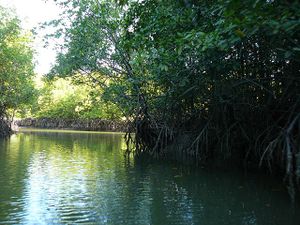Difference between revisions of "Template:This weeks featured article"
(→Mangroves) |
(→Mangroves) |
||
| Line 1: | Line 1: | ||
==Mangroves== | ==Mangroves== | ||
| − | [[image:mangrove thailand.jpg| | + | [[image:mangrove thailand.jpg|right|thumb|300px|caption|Mangal in Thailand <ref>http://teqje.web-log.nl</ref>]] |
This article describes the [[habitat]] of the Mangrove forests. It is one of the sub-categories within the section dealing with biodiversity of [[marine habitats and ecosystems]]. It gives an overview about the characteristics, distribution, biota, functioning and adaptation to general problems the organisms are facing with. A short discussion about the threats is also present. | This article describes the [[habitat]] of the Mangrove forests. It is one of the sub-categories within the section dealing with biodiversity of [[marine habitats and ecosystems]]. It gives an overview about the characteristics, distribution, biota, functioning and adaptation to general problems the organisms are facing with. A short discussion about the threats is also present. | ||
Revision as of 12:01, 26 January 2009
Mangroves

This article describes the habitat of the Mangrove forests. It is one of the sub-categories within the section dealing with biodiversity of marine habitats and ecosystems. It gives an overview about the characteristics, distribution, biota, functioning and adaptation to general problems the organisms are facing with. A short discussion about the threats is also present.
Mangroves are the only trees that are capable of thriving in salt water. They form unique intertidal forests at the edge of land and sea. They are represented on all continents with tropical and subtropical coasts, i.e. North and South America, Africa and Middle-East, Asia and Oceania (incl. Australia). [2]
Mangrove forests or mangals are a type of intertidal wetland ecosystems. The word mangrove is derived from the Portugese word mangue which means “tree” and the English word grove which is used for trees and shrubs that are found in shallow, sandy or muddy areas. [3] They replace Salt marshes in tropical and subtropical regions. They are salt-tolerant forested wetlands at the sea-land interface which forms the link between the terrestrial landscapes and the marine environment. The dominant plants are several species of mangrove (for a species overview, check the Mangrove Species Database [2]). Mangroves are woody trees and shrubs with a thick, partially exposed network of roots that grow down from the branches into the water and sediment. They occur where there is little wave action and where sediments accumulate. These fine grained (muddy and sandy) sediments lack oxygen. [4]
They are frequently associated with saline lagoons and are regularly found on protected sides of islands, atolls and tropical estuaries. [5]- ↑ http://teqje.web-log.nl
- ↑ 2.0 2.1 http://www.vliz.be/vmdcdata/mangroves
- ↑ Karleskint G. 1998. Introduction to marine biology. Harcourt Brace College Publishers. p.378
- ↑ Hogarth P.J. 1999. The biology of mangroves. Oxford University Press. p.228
- ↑ Karleskint G. 1998. Introduction to marine biology. Harcourt Brace College Publishers. p.378
